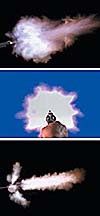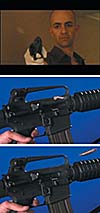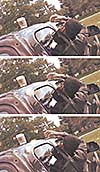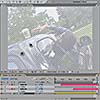Pyrotechnics: Creating Fire, Explosions, and Energy Phenomena in After Effects 7.0
I've become convinced that a significant number of people first became interested in visual effects work because they qualify as borderline pyromaniacs. Creating fire effects entirely on the computer might not be as much fun as being an on-set pyrotechnician, but hey, keeping these people busy with either job is better than letting them loose on society at large.
This article focuses on effects that have traditionally been re-created live on set or via practical elements such as miniatures. The craft of the on-set pyrotechnician is not obsolete by any means, but these days there are many, many cases (particularly the smaller, more common ones) in which compositing can save a lot of time and expense at the shoot, no matter what the budget of the production is. Blowing stuff up on set is fun, but it involves extensive setup and a not insubstantial amount of danger to the cast and crew, and often you get only one take to get it right.
As a director, I would never subject actors to real gunfire and bullet hits on set unless it was clearly the only way to get the image. The death of Brandon Lee on the set of The Crow, when a gun loaded with blanks shot an empty cartridge (still in the barrel from a previous shot) into his abdomen, was fully preventable—not only by a more attentive arms or prop master, but by never loading the gun in the first place. At the risk of sounding glib, it's indisputable that compositing could save a life in this scenario.
And gunfire is only where this article begins. Equally tricky and dangerous on set are explosive bullet hit squibs—small explosives that must be rigged and exploded by an on-set special effects technician, lest anyone damage soft body tissue. You'll learn how to create those effects in After Effects as well. From there, you'll move on to the science-fiction equivalent of gunplay: weapons of pure energy, such as the Star Wars blaster and lightsaber or the Star Trek photon torpedo. After that, it's heat distortion, fire, and explosions.
Then, perhaps, a nice, warm cup of tea.
I hope it's not disappointing that not everything pyrotechnical can be accomplished start-to-finish in After Effects. Some effects require extra preparation of physical or fabricated elements, and all will benefit from your familiarity with good reference. Alas, there's no easy way to create realistic fire or explosions completely from scratch in After Effects, but that doesn't mean that these are off-limits; they're hard to create on computers, period. Compositing may be the key to making these shots work at all.
And, of course, sometimes a storyline calls for the destruction of something that cannot, in real life, be destroyed on any budget. The famous shot of the White House being blown to smithereens in Independence Day is one example, but this limitation was also very much in place on a little-known ABC-TV movie called Superfire, whose concept was articulated as "The Perfect Storm, but with fire." Infernos consuming acres of forest were central to the plot, and even if the budget had allowed for purchasing and razing hundreds of acres of wilderness, environmental concerns—not to mention horrendous PR—would in all cases argue against it. The solution turned out to be varied: in some cases, to composite fire from scratch; in others, to augment what was already there.
To provide examples, this article features stills from low-budget independent films that couldn't afford to create the kind of destruction required onscreen. The Last Birthday Card is a short narrative film that Stu Maschwitz created while still working at Industrial Light & Magic. "http://markandmatty.com/" is a satirical series poking fun at the conventions of action movies with effects (as well as acting), done by Matt Ward, a veteran of Lucasfilm; Industrial Light & Magic; and the late, lamented ESC Entertainment. In both cases, the effects are quick-and-dirty, not meant even for the level of scrutiny they're afforded via the still figures shown here, and intended only to convey the story—which in both cases, incidentally, features hapless victims pursued by unhinged assassins.
Firearms
Re-creating gunplay is relatively straightforward via compositing. The key is that everything happens very quickly—usually over the course of a frame or two, three at most. Two basic types of shots are outlined here: the firing of the gun itself and the result of bullet hits in the scene. The former can be done entirely with compositing. For the latter, compositing helps, but more active scenes of mayhem typically require practical elements, photographed on set.
Ready, Fire, Aim
It can be difficult for actors to work on set without practical effects. The lack of a kick from a handgun, however, shouldn't pose much of a problem. A prop gun clicks when the trigger is pulled, and the actor need only mime the motion of the recoil, or kick. The kick is minor with small handguns, and a much bigger deal with a shotgun (check reference).
So that's how you start, with a shot of an actor pulling the trigger and miming the kick (see Figure 1). From there, you typically add just a few basic elements via compositing:
- Muzzle flash
- Puff of smoke (optional, depending on the lighting and type of gun)
- Discharge of the cartridge or shell (on a semiautomatic)
- Interactive light on the subject firing the gun (depending on the scene lighting and angle)
The actual travel of the bullet out of the barrel isn't something that you have to worry about; at roughly one kilometer per second, it's generally moving too fast to see amid all the other effects. The bullet is usually evident more by what it causes to happen when it hits something, which we'll cover in the next section.

Figure 1 Just by virtue of pulling the trigger on the prop handgun, the actor creates enough motion to set the reaction over which the ensuing muzzle flash will be added. (Image courtesy of http://www.theorphanage.com/.)
Muzzle Flash and Smoke
The clearest indication that a gun has gone off is the flash of light around the muzzle, at the end of the barrel. This small, bright explosion of gunpowder typically lasts only one frame per shot (a repeating firearm is just a series of disconnected single-frame flashes), and it can be painted by hand, cloned in from a practical image, or composited from stock reference (see Figure 2).

Figure 2 The angle of the shot and the type of gun affect the muzzle flash effect. The first image is from an M16 rifle; the other is from a handgun. (Images courtesy of Artbeats.)
Figure 3 shows the addition of a single-frame muzzle flash for the firing of a handgun. Because it's in close-up, the flash obscures much of the frame. It's a mixture of flash and smoke matted in from a pyrotechnic reference shot. All that's really required for this single shot is a single-frame overlay; there's no need to dissipate the smoke to make the shot believable.
Contrast that with Figure 4, which shows a Gatling gun fired from a helicopter. Clearly, this scene has a lot more going on in it than just muzzle flash and smoke. Because it's a repeating gun, the flashes occur on successive frames and the smoke builds up along with debris caused by bullet impacts. The way the shape of the muzzle flash varies over time as well as its relative size and placement are the keys to the shot, picked up from reference.

Figure 3 This close-up of a muzzle flash was added to the plate from Figure 1, using only a single frame of smoke from a photographed source via Add mode. (Image courtesy of The Orphanage.)

Figure 4 The fiery muzzle flash of a Gatling gun has a characteristic teardrop profile shape; here it was painted in from fire source. (Image courtesy of The Orphanage.)
The shape of the muzzle flash depends on the type of gun being fired. Just as when using lens flares and other equipment-specific visual elements, you're encouraged to find a movie that has your gun in it. You can even consult the http://www.nraila.org/ to learn details such as the relationship of the color and amount of smoke to the type of gunpowder.
To summarize, you can easily create custom muzzle flashes as follows:
- Search for (or create) smoke, explosion, or fire source (a still image is good enough). Add it as a layer with a blending mode (typically Add).
- Automatic weaponry demands that you paint frame-by-frame (unless you shoot matching effects source), but especially with good reference showing how crude these flashes are, and their basic shape, this can be quick-and-dirty work, as there's no need for one frame to match the next.
- With any budget for stock footage, you can buy muzzle flashes (such as the http://www.artbeats.com/ Gun Stock collection); these are shot over blue or black, ready to be matted, blended, or painted into your shot.
Shells and Interactive Light
If the gun in your scene calls for it, that extra little bit of realism can be added with a secondary animation of a shell popping off the top of a semiautomatic. Figure 5 shows just such an element in action. All you need is a four-point mask of a white solid, animated and motion-blurred (see Figure 6). You don't have to worry about the color; instead, adjust the element's Opacity to blend it into the scene.

Figure 5 A shell pops off of the fired handgun. Notice that the shell appears only as a blurred, elongated white element in frame, with no discernable detail. A bluescreen shot of an automatic weapon shows a much more discernable shell. (Images courtesy of The Orphanage and Artbeats.)

Figure 6 All that's required to transform a four-point masked white solid to a shell popping off the gun is heavy motion blur and a sufficiently low Opacity setting. (Images courtesy of The Orphanage.)
The bright flash of the muzzle may also cause a brief reflected flash on objects near the gun as well as the subject firing it. Here's the basic methodology: Softly mask a highlight area, and then flash it using an adjustment layer containing a Levels effect or a colored solid with a suitable blending mode.
As a general rule, the lower the ambient light and the larger the weapon, the greater the likelihood of interactive lighting. A literal "shot in the dark" would fully illuminate the face of whomever (or whatever) fired it, just for a single frame. It's a great dramatic effect, but one that's very difficult to re-create in post. This is a rare case where firing blanks on set might be called for, unless you can fake it by dropping in a single-frame still of the brightly lit assassin.
Bullet Hits
Bullets that ricochet on set are known as squib hits because they typically make use of squibs—small explosives with the approximate power of a firecracker that go off during the take. Sometimes squibs are actual firecrackers. It's possible to add bullet hits without using explosives on set, but frenetic gunplay typically will demand a mixture of on-set action and post-production wizardry.
Figure 7 shows a before-and-after shot adding a bullet hit purely in After Effects. In this case, the bullet doesn't ricochet, but is embedded directly into the solid metal of the truck. In such a case, all you need to do is to add the results of the damage on a separate layer at the frame where the bullet hits; you can paint this, or acquire it from stock footage. The element can then be motion-tracked to marry it solidly to the background (see Figure 8).

Figure 7 This sequence of frames shows a second bullet hitting the cab of the truck, using two elements: the painted bullet hit and the spark element, whose source was shot on black and added via Screen mode. (Images courtesy of http://markandmatty.com/".)

Figure 8 The bullet hit is one opportunity to develop your paint skills. The example shows a bullet hole in metal, which has a fairly consistent look. Here, the result is motion-tracked to match the source background plate. (Images courtesy of MarkAndMatty.com.)
At the frame of impact, and continuing a frame or two thereafter, a shooting spark and possibly a bit of smoke (if the target is combustible—not in the case of a steel vehicle) will convey the full violence of the bullets. As with the muzzle flash, this can vary from a single frame to a more fireworks-like shower of sparks tracked in over a few frames (see Figure 9).

Figure 9 A source spark element using Add or Screen blending mode to drop out all of the black background. (Images courtesy of MarkAndMatty.com.)
A bullet hit explosion can be created via a little miniature effects shoot, using a fire-retardant black background (a flat black card might do it) and some firecrackers (assuming that you can get them). The resulting flash, sparks, and smoke stand out against the black, allowing the element to be composited via a blending mode (such as Add or Screen), a hi-con matte, or a plug-in such as http://www.redgiantsoftware.com/downloads/archive-versions/". If dangerous explosives aren't your thing, even in a controlled situation, stock footage is available.
Figure 10 shows a before-and-after shot of a scene that demanded a lot of extra flying debris as the character's apartment was strafed by the previously depicted helicopter. Compositing in this debris after the shot was taken would be highly inconvenient, causing an impractical amount of extra work when compared with firing a BB gun at items on the set and enhancing the effect with sparks and smoke in After Effects (the actual method used).

Figure 10 A BB gun was aimed at various breakaway objects on location while assistants hurled other small objects into the scene to add the necessary amount of debris and mayhem on location. Practical debris is very difficult to add after the fact. (Images courtesy of The Orphanage.)
So, to recap, a good bullet hit should include all of the following:
- Smoke or sparks at the frame of impact, typically lasting between one and five frames
- Physical result of the bullet damage (if any), painted and tracked into the scene
- Debris in cases where the target is prone to shattering or scattering
Later in this article, you'll see how larger explosions have much in common with bullet hits, which are essentially just miniature explosions. In both cases, a bit of practical debris will often enhance believability.